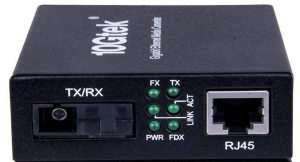Media Converter vs Network Switch
Media converter and network switch are both widely used in today’s high speed network applications. In some scenes, one can used to replace another one. Then, which one should I choose for my network? What is the difference between media converter and network switch? This post will cover the knowledge of media converter and network switch, and explain the difference between them.
1.What is Media Converter?
Media converter is a very simple networking device that used to convert electrical signal utilized in copper cable to light signal for fiber optic cabling and vice versa. It is essential to have the fiber optic connectivity if the distance between two network devices is greater than the copper cabling’s transmission distance. They were introduced to the industry in the 1990s, and played an important part of fiber types of cabling system in connection with existing copper-based wiring system. They are also used in metropolitan area network (MAN) access and data transport services to enterprise customers.
2.What is Network Switch?
A network switch is a computer networking device that connects devices together on a computer network by using packet switching to receive, process, and forward data to the destination device. Usually, a switch serves as a controller, enabling networked devices to talk to each other efficiently. Through information sharing and resource allocation, switches save businesses money and increase employee productivity. And the network switch operates at the data link layer (Layer 2) of the Open Systems Interconnection (OSI) model called layer 2 switch, which operates at the network layer (layer 3) of the OSI model called layer 3 switch.
3.DifferencesBetween Media Converter and Network Switch
In fact, both a media converter and a network switch today can act and perform the same functions. And Both of them operate within the OSI model which is hierarchical and structured in the form of layers such as layer 1, layer 2, layer 3 and so on. A clear understanding of what OSI layers do, and what the differences between devices operating at different layers are, will help you learn about the difference between media converter and network switch.
Layer 1: Media Converter
Layer 1 refers to the Physical Layer, which is the first layer of OSI model. It defines electrical and physical specifications for devices, and the relationship between a device and a transmission medium, such as a copper or optical cable. If a device only operates at Layer 1 of the OSI model, that is usually a media converter. Working at this layer, media converter is used to convert electrical signals and physical media, but don’t do anything for data changes. These media converters usually have only two ports to convert the incoming electrical signal from one cable type and then transmit it over another cable type, such as UTP to fiber and so on.
Layer 2: Media Converter and Network Switch
Layer 2 refers to the Data Link layer of the OSI model. The Data Link layer is concerned with moving data across the physical links in the network. Both media converter and network switch can operate at layer 2. The difference between a layer 2 media converter and a layer 2 network switch is the number of ports. Usually, a device with two or three ports is called a media converter. Compared with layer 1 media converter, a layer 2 media converter can be thought as an advanced converter. A device with four or more ports is called a network switch, and compared with layer 3 switch, a layer 2 switch is usually a basic switch.
Layer 3: Network Switch
Layer 3 refers to the Network layer of the OSI. The Network layer is concerned with knowing the address of the neighboring nodes in the network, selecting routes and quality of service, and recognizing and forwarding to the Transport layer incoming messages for local host domains. Only network switch can operate at Layer 3. Switches operating at Layer 3 are smarter than Layer 2 devices and incorporate routing functions to actively calculate the best way to send a packet to its destination.
Conclusion
Media converters can be used anywhere in the network to integrate newer technology with existing equipment to support new applications, technologies and future growth. Layer 2 and layer 3 network switches are also widely deployed in enterprise and data center for higher speed and more capacity. 10Gtek provides both media converters and managed network switches for your option. You can choose the most suitable one according to your specific needs.


